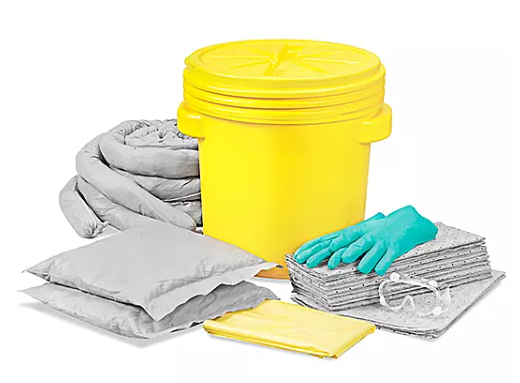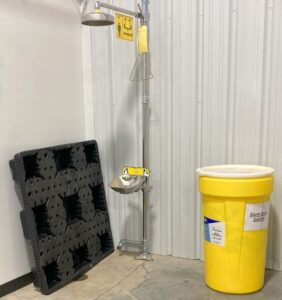Guide to Spill Response Equipment and Kits

Guide to Spill Response Equipment and Kits
Industrial facilities and hazardous material transport vehicles are designed for safety and regulatory compliance. However, leaks and spills do occur occasionally, so it’s important to be prepared. Do you have the appropriate spill response equipment on hand, and, most importantly, do you know how to use it? This guide details the components of a spill control kit, the recommended steps for responding to spills, and the benefits of being prepared.
Spill Kit Essentials
Emergency spill equipment is designed to contain and clean up hazardous materials quickly. Here are the essential components to include in your kit:
Absorbent Materials
- Absorbent Pads are useful for quickly soaking up oil, coolant, and water-based spills. They come in various sizes, but their effectiveness is limited to small spills.
- Socks and booms are ideal for surrounding and containing larger spills. Socks are flexible tubes filled with absorbent material, while booms are larger versions used in bodies of water or around machinery.
- Pillows absorb even larger quantities of liquid and are useful for placing under leaks. They can handle significant volumes and are easy to deploy.
- Loose absorbents are particulate products that soak up liquids and reduce vapors when sprinkled over a spill.
Personal Protective Equipment (PPE)
- Gloves protect your hands from hazardous materials. They should be chemical-resistant and suitable for the specific substances being handled.
- Goggles protect your eyes from splashes and vapors. Ensure they fit snugly against your skin and are made from chemical-resistant materials.
- Aprons, coveralls, and overboots provide body protection. They should fit over your clothes and shoes without encumbering your movements.
- Respirators are necessary when dealing with toxic fumes. They should be compatible with the specific hazards present.
Containment Tools
- Non-absorbent dikes are used to block and divert spills away from sensitive areas like drains and waterways.
- Drain covers prevent spills from entering drainage systems. They must be appropriately sized and compatible with the chemicals involved.
- Drip pans catch small leaks from valves and hose connections. These come in different sizes to handle various volume requirements.
Disposal Bags and Labels
- Disposal bags are for safely collecting and disposing of used absorbents and contaminated materials. These should be clearly marked as hazardous waste.
- Labels identify the contents of disposal bags and containers. Proper labeling is essential for safe handling and regulatory compliance.
Steps to Take After an Emergency Spill
Responding to a spill promptly and effectively promotes safety and reduces contamination. Here’s how to put your spill response gear to good use.
1. Assess the Risk
Determine what product has spilled by checking the container label or Safety Data Sheet (SDS). Then, estimate how much has spilled and assess the primary dangers to cleanup crews and the environment. If the incident poses significant risks, cordon off the area to keep unauthorized personnel away from the spill.
2. Select Your Personal Protective Equipment
To choose the right protective gear, reference the SDS or information from the PPE or chemical manufacturer. If the material is unknown or highly hazardous, opt for the highest level of protection just to be safe. Ensure all responders are trained in the use of PPE to handle different types of spills effectively.
3. Confine the Spill
Deploy the appropriate absorbents to contain the spill and prevent it from spreading. Place non-absorbent barriers far enough from the spill to protect sensitive areas like drains and waterways.
4. Stop the Leak
Locate the source of the spill and take steps to correct it. This might involve turning a container upright, tightening a valve, or sealing a puncture. If possible, transfer the remaining contents from the damaged container to a new, intact one to prevent further leaks.
5. Reevaluate and Implement Cleanup Measures
After containing the spill, reassess the situation to ensure no further risks are present. Gather your spill cleanup equipment and ensure you have enough absorbent materials and tools to manage the cleanup process. Soak up the spill with absorbent materials, starting from the perimeter and working inward. Collect all saturated materials for proper labeling and disposal.
6. Decontaminate the Site
Once the spill is absorbed, remove or neutralize any hazardous materials left behind. This may include decontaminating surfaces, soil, or equipment. Set up designated areas for cleaning responders and equipment to ensure thorough decontamination. Finally, assess whether your PPE can be cleaned and reused or if it needs to be disposed of as hazardous waste.
7. Complete the Required Reports
Record all the details of the spill incident, including the suspected cause, the actions taken, and the spill response supplies used. Restock your spill control kit so you’re ready for the next incident. Lastly, file all necessary reports with local and national authorities, including medical reports, environmental reports, and internal safety reports.
Benefits of Being Prepared
Having the right equipment and training to handle spills can benefit your industrial facility in several ways:
- Prevent costly damage to equipment and property.
- Avoid environmental violations that may result in hefty fines and legal fees.
- Ensure employee confidence and safety during the cleanup process.
- Protect the environment from hazardous materials that could contaminate the soil, water, and air.
- Minimize disruption to business operations so you can resume normal activities more quickly.
- Improve preparedness to ensure your employees are ready to respond effectively to the next incident.
Request Emergency Spill Response and Remediation
At EnviroBEE, we know that a rapid, effective response is the best way to handle any spill. As a reliable cleanup company serving the Carolinas and Virginia, we offer 24/7 response to emergency spills in Fayetteville, Raleigh, and beyond. Our company founder, Bill Boyer, has over 20 years of environmental remediation experience, so you can trust us to handle hazardous waste cleanup safely and efficiently. Contact us today to help safeguard your facility and the environment.

